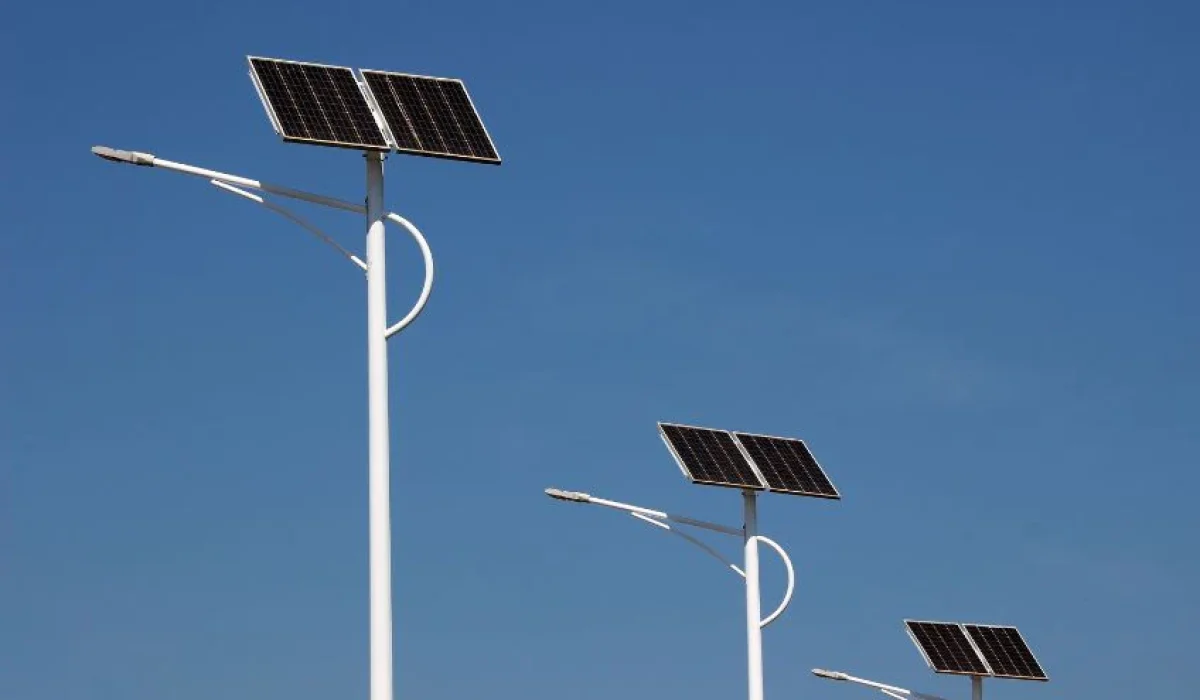In over fifteen years of delivering solar street lighting projects across Africa and the Middle East, one question keeps resurfacing: are solar street lights really more economical than grid-powered systems?
The short answer—yes. When we measure the Total Cost of Ownership (TCO) over a 10-year lifecycle, well-designed solar street lights consistently save between 20–30% compared to conventional street lighting.
This article breaks down exactly where those savings come from, what EPC contractors and governments should consider, and how to structure projects for maximum ROI.
What is Total Cost of Ownership (TCO) in Solar Street Lighting?
TCO refers to all costs incurred during the full lifecycle of a street lighting project—not just the upfront purchase price.
For solar street lights, TCO includes:
- Procurement costs (fixtures, poles, batteries, shipping)
- Civil works & installation (foundations, trenching, cabling, labor)
- Energy costs (grid electricity or zero for solar)
- Maintenance costs (lamp replacement, battery servicing, pole anti-corrosion treatments)
- Financing & administrative costs (tenders, approvals, taxes, import duties)
When we put these together across 10 years, the solar model pulls ahead.
Where Do the 20–30% Savings Come From?
Solar street lights cut costs at multiple stages of a project lifecycle.
| Cost Component | Grid-Powered Street Light (10 Years) | Solar Street Light (10 Years) | Savings |
|---|---|---|---|
| Civil Works & Cabling | High – trenching, conduit, cabling | Very Low – only pole footing | 50–70% |
| Energy Consumption | High – monthly utility bills | Zero – sunlight powered | 100% |
| Maintenance & Replacements | Frequent – bulbs, cables, power surges | Low – LED ≥230 lm/W, LiFePO₄ ≥6000 cycles | 40–50% |
| Project Delays & Financing | Higher – permits, utility approvals | Lower – independent system | 15–20% |
| Total 10-Year Cost | 100% baseline | 70–80% of baseline | 20–30% saved |
Why Do Civil Works Account for the Biggest Savings?
Civil works (trenching, wiring, transformer connections) often make up 30–40% of grid-lighting budgets.
With solar, you eliminate:
- Road trenching (no disruption to traffic or underground utilities)
- Long cable runs (no copper theft risk, no voltage drop issues)
- Transformer connection fees
In one Nigerian municipal project, avoiding trenching across 12 km of road cut project costs by nearly USD 450,000—almost 25% of the budget.
How Do Energy Savings Accumulate Over 10 Years?
- Grid-powered 150W sodium lamps consume ~650 kWh/year each.
- At an average electricity tariff of USD 0.18/kWh (typical in Africa), that’s USD 117 per lamp per year.
- Over 10 years, USD 1,170 per unit is spent on energy alone.
Solar street lights? Zero.
For a 500-unit city project, the avoided energy bill exceeds USD 585,000 in 10 years.
What About Maintenance and Battery Replacement Costs?
Modern solar street lights use:
- High-efficiency LEDs ≥230 lm/W (lasting 50,000+ hours).
- LiFePO₄ batteries with ≥6000 cycles (8–10 year lifespan).
- IP66/IK09 certified fixtures (resistant to dust, water, vandalism).
This means far fewer service calls compared to grid systems, which face cable faults, power surges, and frequent bulb replacements.
Yes, batteries must eventually be replaced, but even factoring that in, maintenance costs remain 40–50% lower than grid-based lights.
Why Faster Deployment Reduces Hidden Costs?
EPC contractors know that every month of delay adds hidden costs:
- Contractor overheads increase.
- Financing interest accumulates.
- Community dissatisfaction rises.
Because solar lights don’t need utility approval or grid connection, deployment is 2–3x faster. For a 10 km road project, this can reduce indirect costs by 15–20%.
Case Study: 500 Solar Street Lights in Burkina Faso
In 2024, we deployed 500 sets of 60W solar street lights on 7m poles in Burkina Faso.
- High-efficiency LEDs (230 lm/W) reduced the system wattage needed, lowering procurement cost.
- No trenching or cabling saved USD 300,000 in civil works.
- Zero electricity bills will save USD 600,000 across 10 years.
- Projected TCO savings: 27% compared to grid design.
The government’s budget stretched further—lighting more kilometers with the same funds.
What Should EPCs and Governments Consider Before Choosing Solar?
- Component Quality Matters – Don’t chase fake “200W” lamps; look for tested 60–80W units with ≥230 lm/W efficiency.
- Lifecycle, Not Price Tag – A cheap unit saves little if it fails in 3 years.
- Local Conditions – Consider salt-spray resistance (ports), dust protection (deserts), and anti-theft pole designs (urban).
- Compliance & Financing – Ensure IEC/ISO certifications, and explore SINOSURE-backed financing for large-scale projects.
Key Takeaways: Why Solar Street Lights Win on TCO
- 20–30% cheaper over 10 years when lifecycle costs are compared.
- Zero electricity bills with renewable energy.
- Lower civil works and faster installation reduce upfront budget pressure.
- Fewer maintenance interventions thanks to durable, efficient components.
- Scalable financing models make them feasible even for cash-strapped municipalities.
Final Word
After 15 years in the field, I’ve seen the numbers play out in real tenders and deployments. Solar street lights are no longer a “green option”—they are the financially smarter choice.
If you are planning a government or EPC-led project, analyze the TCO—not just the purchase order. That’s where solar delivers its true 20–30% advantage.
📩 Contact Sunlurio today to request a detailed TCO comparison tailored to your next project.


